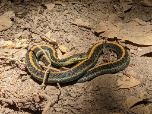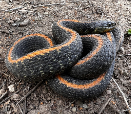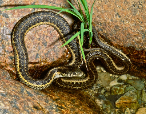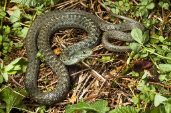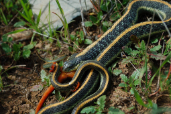Aquatic Garter Snake (Thamnophis atratus)
Description: The aquatic garter snake grows up to 18-40 inches long. Its dorsal coloration varies greatly. The different coloration patterns are: pale gray with alternating rows of darker blotches on the sides, dark brown with borders that are less distinct, or nearly all black. A long yellow stripe running down the back may be present or absent, only confined to the neck, or just very indistinct. The throat and underside of the snake are whitish to yellow.
One color morph of the aquatic garter snake has a blue-gray background color with a faint olive-colored dorsal stripe and white dots along its sides. Another color morph has a yellow dorsal stripe with black spots along its sides. The second color morph has the more classic garter snake look; however, due to its behavior and scalation, it is grouped in this species.
Habitat: It can most commonly be found on the edges of bushlands, woodlands, grasslands, and forests near ponds, marshes, streams and lakes.
Range: It is found exclusively along the coast of Oregon and California.
Found in these States:
CA |
OR
Diet: Forages in water; eats fishes (including sculpins and trout up to 2.4 cm in length), tadpoles (though not especially effective as a predator of bullfrog larvae, frogs (e.g., RANA BOYLII), salamanders, and salamander (e.g., DICAMPTODON) larvae
Reproduction: The aquatic garter snake bears live young. Mates in spring; young are born August-October. Broods consist of three to 12 young.
Status: Listed as Least Concern in view of its wide distribution, presumed large population, and because it is unlikely to be declining fast enough to qualify for listing in a more threatened category.
»» Kingdom: Animalia - Animals
»» Phylum: Chordata - Chordates
»» Subphylum: Vertebrata - Vertebrates
»» Class: Reptilia - Reptiles
»» Order: Squamata - Scaled Reptiles
»» Suborder: Serpentes
»» Superfamily: Colubroidea
»» Family: Colubridae - Colubrids
»» Genus: GENUS
»» Species: Thamnophis atratus - Aquatic Garter Snake
»» Subspecies: Three:
»» Thamnophis atratus atratus - Santa Cruz Aquatic Garter Snake
»» Thamnophis atratus hydrophilus - Oregon Aquatic Garter Snake
»» Thamnophis atratus zaxanthus - Diablo Range Garter Snake
This article uses material from the Wikipedia article "Aquatic Garter Snake", which is released under the Creative Commons Attribution-Share-Alike License 3.0. Content may have been omitted from the original, but no content has been changed or extended.
|




